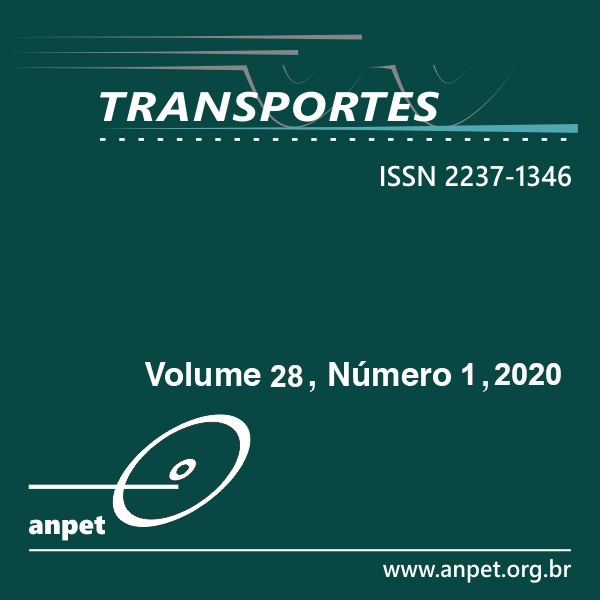Avaliação da percepção de segurança em relação à presença de três tipos de infraestrutura cicloviária em cruzamentos não semaforizados
DOI:
https://doi.org/10.14295/transportes.v28i1.1968Keywords:
Cycling infrastructure, Road safety, Safety perception.Abstract
At intersections, the concentration of traffic conflicts and riding amidst motorized vehicles cause a sensation of insecurity in the cyclists. For that matter, several authors cite the implementation of cycling infrastructure as a determining factor to promote bicycle users’ safety perception. Thus, this study aims to investigate safety perception at non-signalized urban intersections in terms of presence of cycling infrastructure. The methodology applied was based on the application of an online survey assessing cyclist's perception in a set of intersection scenarios with cycling infrastructure, all based in Brazilian scenarios. Data were analyzed by methods of inferential statistics, in which were compared safety perception by type of cycling infrastructure. Results show that intersections with cycling track in the median are perceived as the safest, while intersections with shared lanes as the most unsafe.Downloads
References
Brasil (2010). Departamento Nacional de Infraestrutura de Transportes. Diretoria Executiva. Instituto de Pesquisas Rodovi-árias. Manual de projeto geométrico de travessias urbanas. - Rio de Janeiro. 392p. (IPR. Publ., 740).
Chataway, E. S.; Kaplan, S.; Nielsen, T. A. S.; Prato, C. G. (2014). Safety perceptions and reported behavior related to cycling in mixed traffic: A comparison between Brisbane and Copenhagen. Transportation Research Part F, n. 23, p. 32–43. DOI: 10.1016/j.trf.2013.12.021
Chaurand, N.; Delhomme, P. (2013). Cyclists and drivers in road interactions: A comparison of perceived crash risk. Accident Analysis and Prevention, v. 50, p. 1176-1184. DOI: 10.1016/j.aap.2012.09.005
Denver Public Works (2016). Bicycle crash analysis: understanding and reducing bicycle & motor vehicle crashes. Denver, CO: Transportation and Mobility.
Elvik, R. (2009). An exploratory analysis of models for estimating the combined effects of road safety measures. Accident Analysis and Prevention, v. 41, p. 876-880. DOI: 10.1016/j.aap.2009.05.003
EMBARQ (2015). Cities Safer by Design: Guidance and Examples to Promote Traffic Safety Through Urban and Streets Design. World Resources Institute.
Ferraz, A. C.; Raia Jr., A.; Bezerra, B; Bastos, T.; Rodrigues, K. (2012). Segurança Viária, São Carlos: Suprema Gráfica e Editora.
FHWA – Federal Highway Administration (2006). Lesson 3: Pedestrian and Bicyclist Safety. McLean, VA: Turner-Fairbank High-way Research Center.
Heinen, E.; Van Wee, B.; Maat, K. (2010). Commuting by Bicycle: An Overview of the Literature. Transport Reviews, , v. 30, n. 1, p. 59–96. DOI: 10.1080/01441640903187001
IPEA – Instituto De Pesquisas Econômicas Aplicadas (2015). Acidentes de trânsito nas rodovias federais brasileiras: caracteri-zação, tendências e custos para a sociedade. Brasília: Livraria Ipea.
Isaksson-Hellman, I. (2012). A study of bicycle and passenger car collisions based on insurance claims data. In: 56th AAAM Annual Conference, 2012. Annals of Advances in Automotive Medicine, v. 56, p. 3-12.
Johnson, M.; Chong, D.; Carroll, J; Katz R.; Oxley, J.; Charlton, J. (2014). Naturalistic Cycling Study: Identifying Risk Factors for Cyclists in the Australian Capital Territory. Monash University: Accident Research Centre.
Kaplan, S.; Prato, C. G. (2013). Cyclist–Motorist Crash Patterns in Denmark: A Latent Class Clustering Approach. Traffic Injury Prevention, v. 14, n. 7, p. 725–733. DOI: 10.1080/15389588.2012.759654
Landis, B.; Vattikuti, V. R.; Ottenberg, R. M.; Petritsch, T. A. (2003). Intersection Level of Service for the Bicycle Through Move-ment. Transportation Research Record. v. 1828, p. 101-106. DOI: 10.3141/1828-12
Lusk, A. C.; Furth, P. G.; Morency, P.; Miranda-Moreno, L. F.; Willett, W. C.; Dennerlein, J. T. (2011). Risk of injury for bicycling on cycle tracks versus in the street. Injury Prevention, v. 17, p. 131–135. DOI: 10.1136/ip.2010.028696
Manton, R.; Rau, H.; Fahy, F.; Sheahan, J.; Clifford, E. (2016). Using mental mapping to unpack perceived cycling risk. Accident Analysis and Prevention, v. 88, p. 138-149. DOI: 10.1016/j.aap.2015.12.017
Menghini G.; Carrasco, N.; Schüssler, N.; Axhausen, K. W. (2010). Route choice of cyclists in Zurich. Transportation Research Part A, v. 44, p. 754-765. DOI: 10.1016/j.tra.2010.07.008
Minikel, E. (2012). Cyclist safety on bicycle boulevards and parallel arterial routes in Berkeley, California. Accident Analysis and Prevention, v. 45, p. 241-247. DOI: 10.1016/j.aap.2011.07.009
Moller, M.; Hels, T. (2008). Cyclists’ perception of risk in roundabouts. Accident Analysis and Prevention, v. 40, n. 3, p. 1055-1062. DOI: 10.1016/j.aap.2007.10.013
NACTO (2014). Urban Bikeway Design Guide. 2 ed. Washington, DC: National Association of City Transportation Officials.
Ng, A.; Debnath, A. K.; Heesch, K. C. (2017). Cyclist’ safety perceptions of cycling infrastructure at un-signalised intersections: Cross-sectional survey of Queensland cyclists. Journal of Transport & Health. v. 6, p. 13-22. DOI: 10.1016/j.jth.2017.03.001
Nordback, K.; Marshall, W. E.; Janson, B. N. (2014). Bicyclist safety performance functions for a U.S. city. Accident Analysis and Prevention, n. 65, p. 114-122. DOI: 10.1016/j.aap.2013.12.016
O’Connor, J. P.; Brown, T. D. (2010). Riding with the sharks: Serious leisure cyclist’s perceptions of sharing the road with motorists. Journal of Science and Medicine in Sport, v. 13, p. 53-58. DOI: 10.1016/j.jsams.2008.11.003
Rasanem, M.; Summala, H. (1998). Attention and expectation problems in bicycle–car collisions: An in-depth study. Accident Analysis and Prevention, v. 30, n. 5, p. 657-666.
Rosenberg, A. (2015). Uso de bicicletas no Brasil: Qual melhor modelo de incentivo?. Rosenberg Associados: Brasil.
Teschke, K.; Harris, A.; Reynolds, C. C. O.; Winters, M.; Babul, S.; Chipman, M.; Cusimano, M. D.; Brubacher, J. R.; Hunte, G.; Friedman, S. M.; Monro, M.; Shen, H.; Vernich, L.; Cripton, P. A (2012). Route Infrastructure and the Risk of Injuries to Bi-cyclists: A Case-Crossover Study. American Journal of Public Health. v. 102, n. 12, p. 2336-2343. DOI: 10.2105/AJPH.2012.300762
Wachtel, B. A.; Lewiston, D. (1994). Risk factors for bicycle-motor vehicle collisions at intersections. ITE Journal, v. 64, n. 9, p. 30-35.
Waiselfisz, J. J. (2013). Mapa da Violência 2013: Acidentes de Trânsito e Motocicletas. Rio de Janeiro: CEBELA.
Wang, Y.; Nihan, N. L. (2004). Estimating the risk of collisions between bicycles and motor vehicles at signalized intersections. Accident Analysis and Prevention, v. 36, n. 2, p. 313-321. DOI: 10.1016/S0001-4575(03)00009-5
Wei, F.; Lovegrove, G. (2013). An empirical tool to evaluate the safety of cyclists: Community based, macro-level collision pre-diction models using negative binomial regression. Accident Analysis and Prevention, v. 61, p. 129-137. DOI: 10.1016/j.aap.2012.05.018
Weigand, L. (2008). A Review of Literature: Intersection Treatments to Improve Bicycle Access and Safety. Portland: Center for Transportation Studies, Portland State University.
Wegman, F.; Zhang, F.; Dijkstra, A. (2012). How to make more cycling good for road safety?. Accident Analysis and Prevention, v. 44, n. 1, p. 19-29. DOI: 10.1016/j.aap.2010.11.010
Welle, B.; Li, W.; Adriazola-Steil, C. A. (2016). What Makes Cities Safer by Design? A Review of Evidence and Research on Prac-tices to Improve Traffic Safety Through Urban and Street Design. Transportation Research Board: 95th Annual Meeting Compendium of Papers.
WHO – World Health Organization (2018). Global status report on road safety 2018. Geneva: World Health Organization.
Downloads
Published
How to Cite
Issue
Section
License
Authors who submit papers for publication by TRANSPORTES agree to the following terms:
- The authors retain the copyright and grant Transportes the right of first publication of the manuscript, without any financial charge, and waive any other remuneration for its publication by ANPET.
- Upon publication by Transportes, the manuscript is automatically licensed under the Creative Commons License CC BY 4.0 license. This license permits the work to be shared with proper attribution to the authors and its original publication in this journal, and to be adapted for non-commercial purposes, provided appropriate credit is given and any derivative works are distributed under the same terms.
- Authors are authorized to enter into additional separate contracts for the non-exclusive distribution of the version of the manuscript published in this journal (e.g., publishing in an institutional repository or as a book chapter), with recognition of the initial publication in this journal, provided that such a contract does not imply an endorsement of the content of the manuscript or the new medium by ANPET.
- Authors are permitted and encouraged to publish and distribute their work online (e.g., in institutional repositories or on their personal websites) after the editorial process is complete. As Transportes provides open access to all published issues, authors are encouraged to use links to the DOI of their article in these cases.
- Authors guarantee that they have obtained the necessary authorization from their employers for the transfer of rights under this agreement, if these employers hold any copyright over the manuscript. Additionally, authors assume all responsibility for any copyright infringements by these employers, releasing ANPET and Transportes from any responsibility in this regard.
- Authors assume full responsibility for the content of the manuscript, including the necessary and appropriate authorizations for the disclosure of collected data and obtained results, releasing ANPET and Transportes from any responsibility in this regard.









